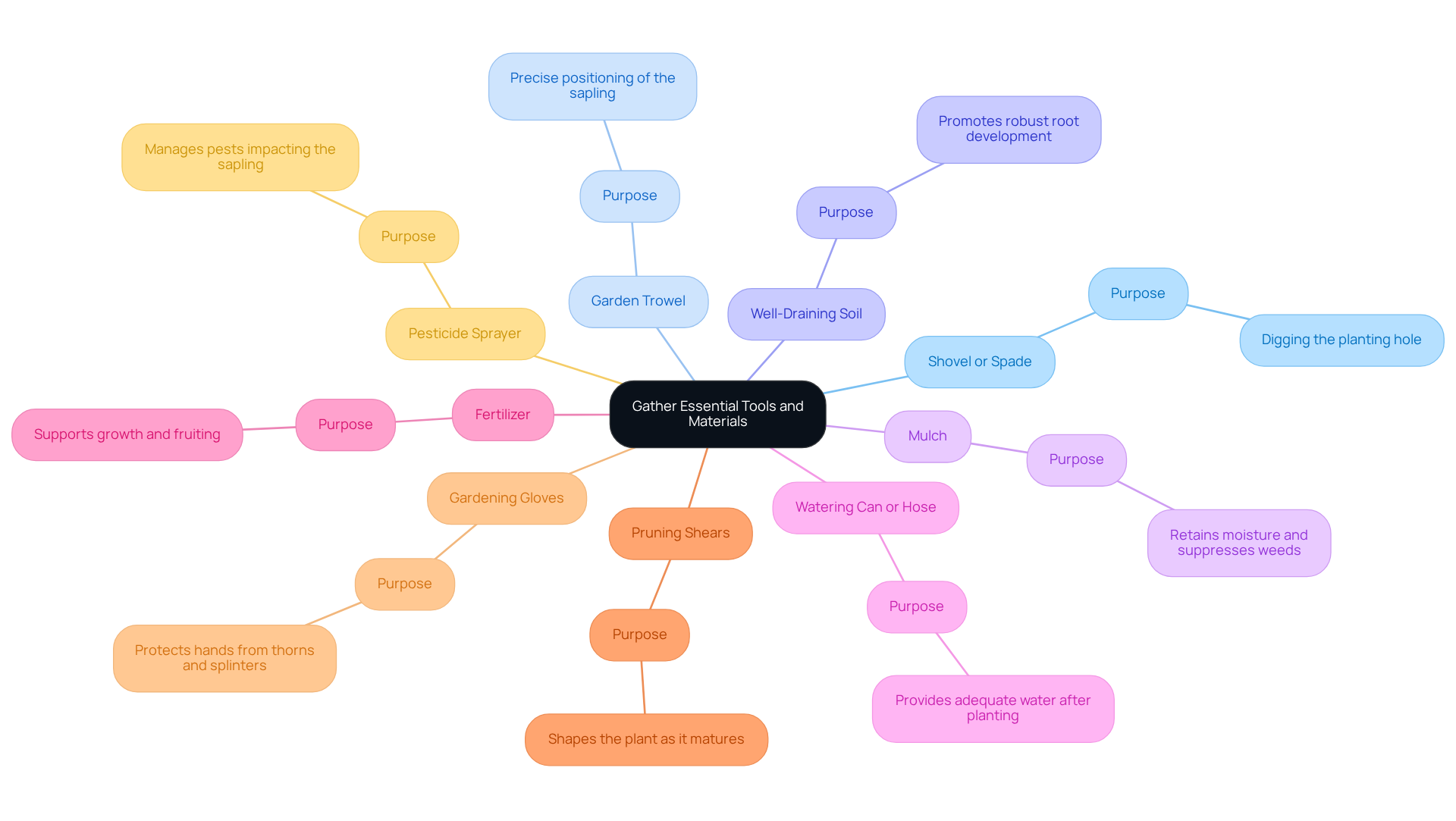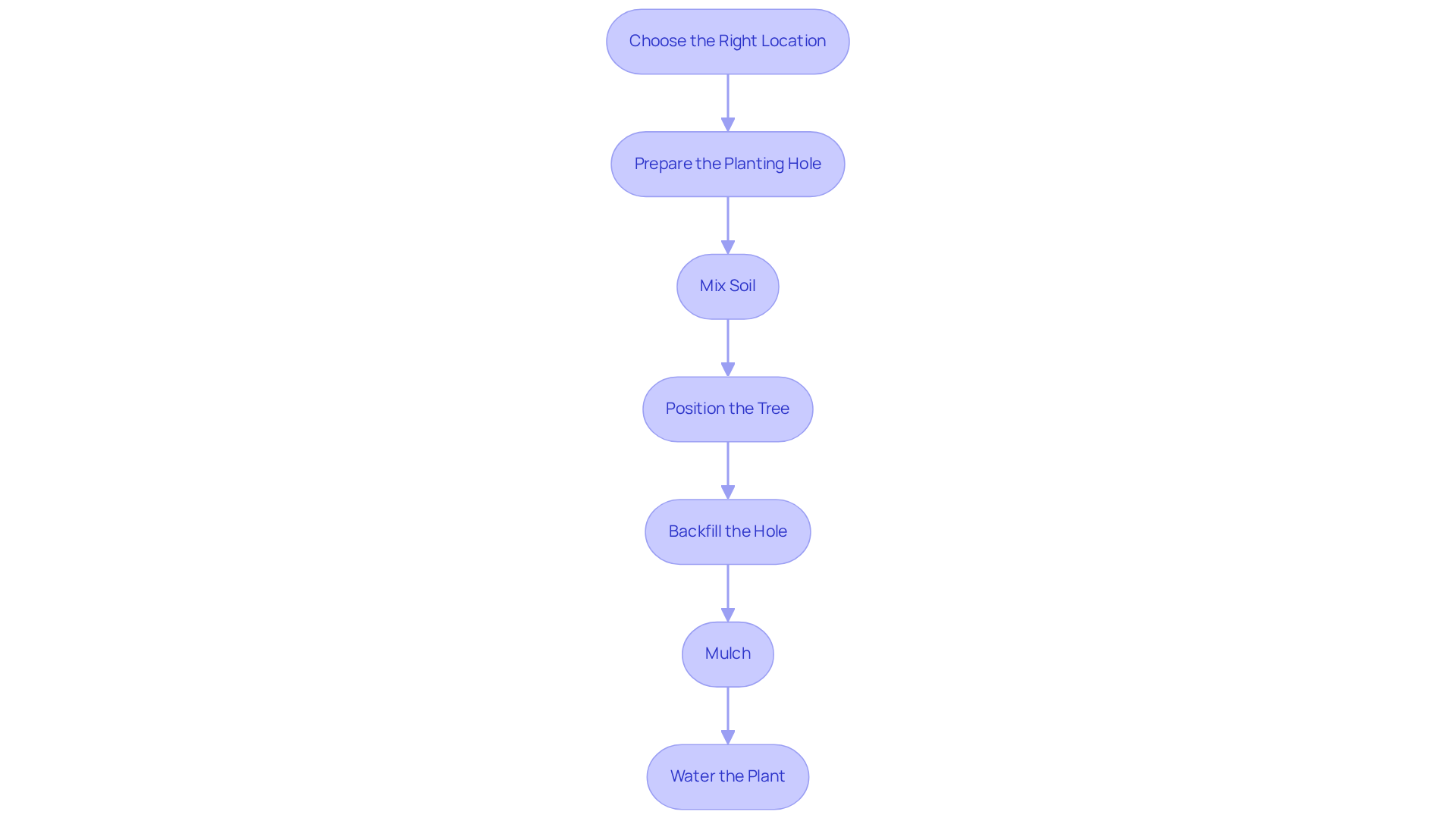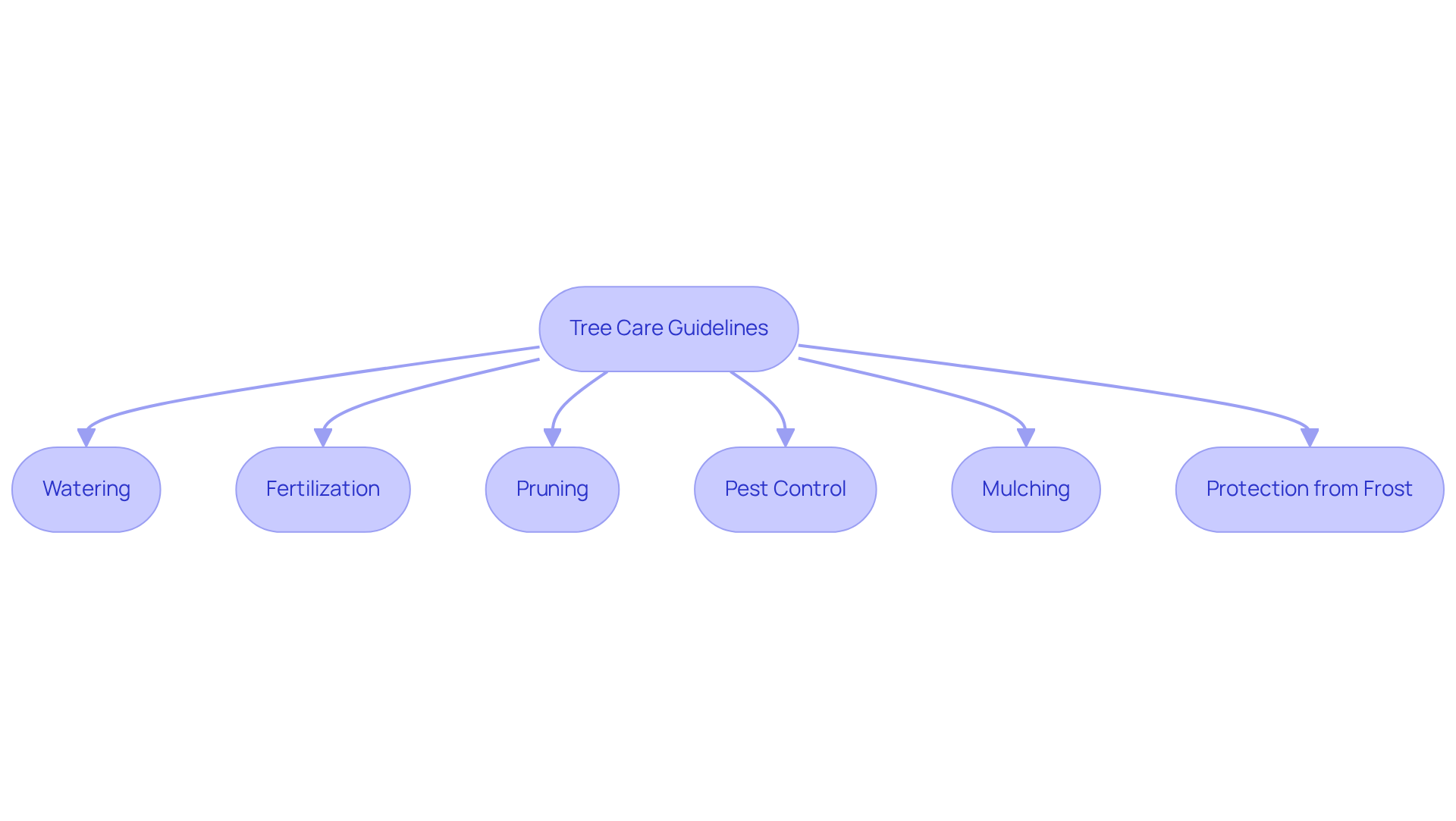
How to Grow Your Cotton Candy Mango Tree Successfully
Share
Growing a Cotton Candy Mango tree can transform any garden into a tropical paradise. However, the journey from sapling to fruit-bearing tree requires careful planning and execution. This guide offers essential steps and insights that not only ensure successful planting but also promote optimal growth and fruit production.
With numerous variables at play—from soil conditions to pest management—navigating the challenges that may arise along the way is crucial. By understanding these factors, you can cultivate a thriving tree that enhances your garden's beauty and productivity.
🥭 Want to grow Cotton Candy Mango in your garden?
Explore Cotton Candy Mango Tree at Everglades Farm - shipped directly from Florida.
1. Gather Essential Tools and Materials
To successfully plant your Cotton Candy Mango tree, it is essential to gather the following tools and materials, each serving a specific purpose in the planting process:
- Shovel or Spade: This tool is necessary for digging the planting hole, ensuring it is deep and wide enough to accommodate the root system of the mango tree.
- Garden Trowel: Ideal for detailed soil tasks, the garden trowel allows for precise positioning, enabling careful placement of the sapling.
- Well-Draining Soil: A combination of sandy loam and compost is ideal for mango plants, promoting robust root development while avoiding waterlogging, which is crucial for successful cultivation.
- Mulch: Organic mulch plays a vital role in retaining moisture and suppressing weeds, creating a favorable environment for growth.
- Watering Can or Hose: Providing adequate water to the plant after planting is essential for ensuring it establishes well in its new location.
- Fertilizer: A balanced fertilizer with a higher potassium content is recommended to support the growth and fruiting of mango plants.
- Pruning Shears: These are essential for shaping the plant as it matures, helping to preserve its health and productivity.
- Gardening Gloves: High-quality gloves protect your hands from thorns and splinters while working in the garden.
- Pesticide Sprayer: Having a pesticide sprayer available is advisable for managing pests that may impact your newly planted sapling.
Having these items ready before you begin the planting process will facilitate a smooth and successful experience. As noted by gardening expert Angela Williams, utilizing the right tools is vital for effective gardening practices.

2. Plant Your Cotton Candy Mango Tree
To successfully plant your Cotton Candy Mango tree, follow these essential steps:
-
Choose the Right Location: Select a site that receives full sun for at least 6 to 8 hours daily. Ensure the area has well-draining soil, avoiding heavy shade or waterlogged conditions that can hinder growth.
-
Prepare the Planting Hole: Dig a hole that is twice as wide and deep as the tree's ball of roots. This provides ample space for the plants to grow and secure themselves effectively.
-
Mix Soil: Enhance the native soil by mixing it with compost to improve drainage and nutrient content. The resulting mixture should be loose and well-aerated, encouraging healthy growth.
-
Position the Tree: Place the tree in the center of the hole, ensuring that the top of the ball of soil sits slightly above ground level. This positioning helps prevent water from accumulating around the trunk, which can lead to rot.
-
Backfill the Hole: Carefully fill the hole with the earth mixture, gently tamping it down to eliminate any air pockets. Water the area thoroughly to help settle the soil around the cotton candy mango plants.
-
Mulch: Apply a layer of organic mulch around the base of the plant, keeping it a few inches away from the trunk to avoid moisture buildup that could cause rot.
-
Water the plant thoroughly after planting to aid in establishing the roots and ensuring a strong start for your Cotton Candy Mango.
Incorporating best management practices, such as proper fruit thinning and pruning, can further enhance the growth and yield of your mango plant. Additionally, consider pest management strategies effective for both mango and soursop plants, such as regular inspections and organic treatments to prevent infestations. As noted by Trent Blare, an assistant professor in the Food and Resource Economics Department, "Proper planting techniques are essential for the successful establishment of mango plants." Furthermore, keep in mind that a matured mango plant can yield about 275 pounds of fruit, setting realistic expectations for your gardening efforts.

3. Maintain and Care for Your Tree
To maintain and care for your Cotton Candy Mango tree, adhere to the following guidelines:
-
Watering: Ensure the tree receives adequate water, particularly during dry spells. The ground should stay consistently damp but not saturated. Initially, water deeply every 2-3 days for the first few months to establish a strong root system. As the plant grows, modify the watering frequency to every 10-14 days during dry spells, depending on precipitation and moisture levels in the ground. Regularly monitor soil moisture levels using tensiometers or by inserting a finger or soil moisture meter to ensure proper hydration.
-
Fertilization: Implement a structured fertilization schedule by applying a balanced fertilizer every 6-8 weeks during the growing season (spring and summer) to promote the growth of cotton candy mango. This practice supports healthy growth and enhances fruit production. Furthermore, think about utilizing nutritional sprays from March through September to supply vital micronutrients that enhance the health of the plant.
-
Pruning: Conduct annual pruning to remove dead or crossing branches and to shape the canopy. This not only promotes better air circulation and sunlight penetration but also encourages a more robust fruit set.
-
Pest Control: Regularly examine the plant for pests such as aphids and scale insects. If infestations occur, utilize organic insecticides or neem oil to manage the situation effectively.
-
Mulching: Maintain a 2-4 inch layer of organic mulch around the base of the plant to retain soil moisture, suppress weeds, and regulate soil temperature. Ensure the mulch is kept at least 6 inches away from the trunk to prevent rot.
-
Protection from Frost: During cooler months, safeguard the plant from frost damage by covering it with a frost blanket on cold nights. This protection is vital for preserving the plant's health during winter.

4. Troubleshoot Common Growth Issues
When encountering challenges with your Cotton Candy Mango tree, consider these effective troubleshooting strategies:
- Yellowing Leaves: This symptom often indicates overwatering or a nutrient deficiency. Ensure your soil has good drainage and contemplate using a professional-grade fertilizer specifically formulated for fruit plants to restore nutrient levels.
- Stunted Growth: If your plant's growth appears sluggish, investigate potential root rot or inadequate soil conditions. Plant your sapling in well-draining soil and adjust your watering practices to promote healthy growth.
- Pest Infestations: Look for signs of pests, such as webbing or sticky residue on leaves. To manage infestations, treat your plant with organic insecticides or neem oil, both effective and environmentally friendly options.
- Poor Fruit Production: Insufficient sunlight or improper fertilization can impede fruit production. Ensure your plant receives ample sunlight and consider revising your fertilization schedule to meet its specific needs.
- Leaf Drop: Environmental stress, such as sudden temperature fluctuations, can lead to leaf drop. Protect your plant from extreme weather and maintain consistent care to minimize stress.
By applying these guidelines, you can effectively troubleshoot and nurture a thriving cotton candy mango plant. Remember, Everglades Farm emphasizes the joy of gardening and provides high-quality trees that arrive in optimal condition, ensuring a rewarding gardening experience.
Conclusion
Successfully growing a Cotton Candy Mango tree requires a combination of proper preparation, diligent care, and effective troubleshooting. By adhering to the outlined steps, gardeners can create an optimal environment for their mango tree to thrive, ensuring not only survival but also flourishing and the production of delicious fruit.
Key practices include:
- Selecting the right tools for planting
- Ensuring appropriate site selection
- Maintaining a consistent care routine that encompasses watering, fertilization, and pest management
- Regular pruning and mulching, which are vital for promoting healthy growth and maximizing fruit yield
Additionally, being vigilant about potential growth issues and implementing appropriate solutions can significantly enhance the overall health of the tree.
Embracing these techniques enriches the gardening experience and contributes to a fruitful harvest. With patience and commitment, every gardener can enjoy the sweet rewards of their labor, transforming their Cotton Candy Mango tree into a thriving centerpiece of their garden. Start your journey today and cultivate a slice of tropical paradise right in your backyard.
🥭 Cultivate Your Tropical Paradise Today!
Start your journey with Everglades Farm and grow your very own Cotton Candy Mango tree!
🥭 Buy Cotton Candy Mango tree
🥭 Explore Mango Trees for sale
Frequently Asked Questions
What tools are necessary for planting a Cotton Candy Mango tree?
The essential tools include a shovel or spade, garden trowel, watering can or hose, pruning shears, and gardening gloves.
Why is well-draining soil important for mango plants?
Well-draining soil, ideally a combination of sandy loam and compost, promotes robust root development and prevents waterlogging, which is crucial for successful cultivation.
What role does mulch play in planting a mango tree?
Organic mulch helps retain moisture and suppress weeds, creating a favorable environment for the growth of the mango tree.
What type of fertilizer is recommended for mango plants?
A balanced fertilizer with a higher potassium content is recommended to support the growth and fruiting of mango plants.
How can I manage pests on my newly planted mango sapling?
A pesticide sprayer is advisable for managing pests that may impact your newly planted sapling.
What should I do after planting to ensure the mango tree establishes well?
Providing adequate water to the plant after planting is essential for ensuring it establishes well in its new location.


